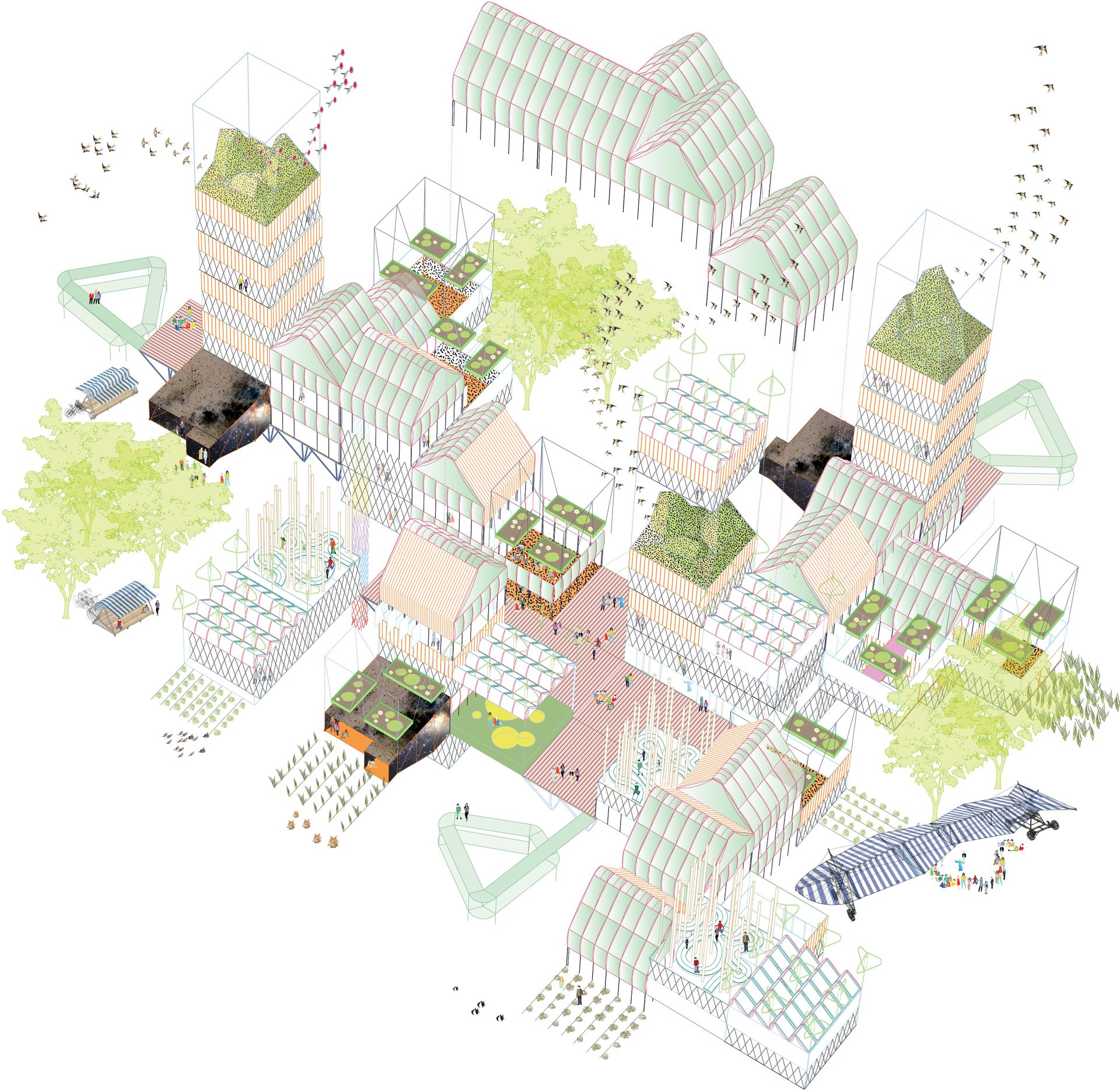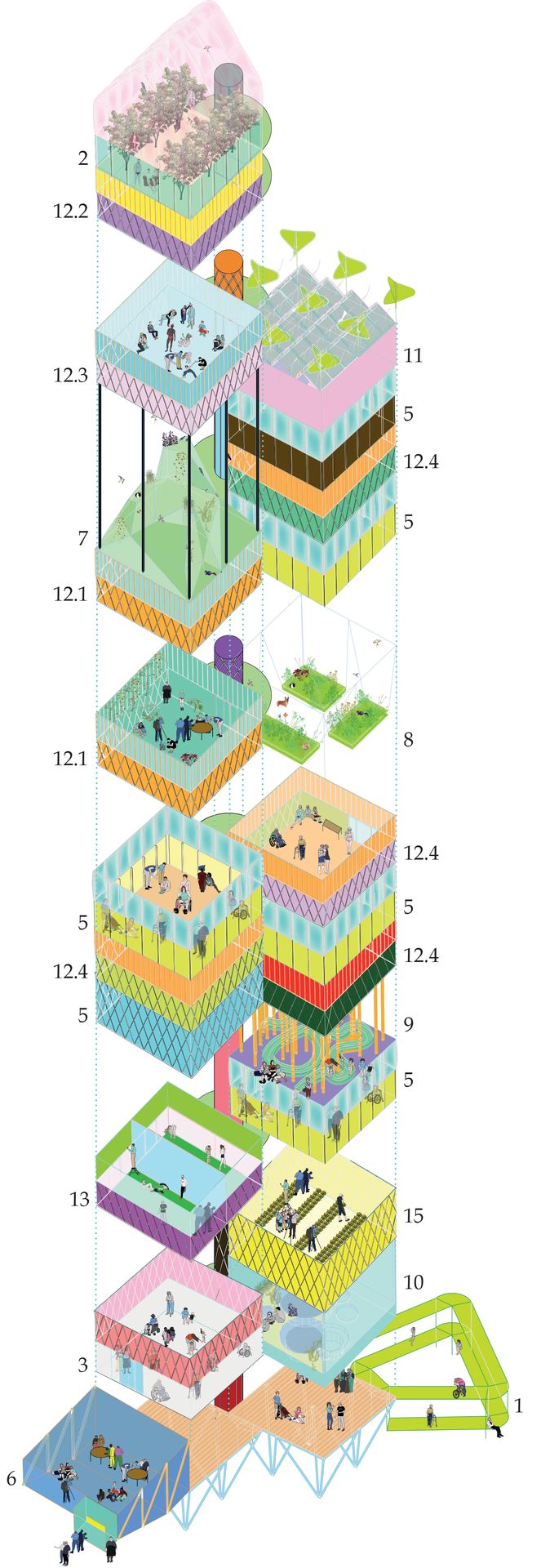About the project
- Dependency is the new centrality
Facts. Fourteen percent of people in Upplands Väsby are considered dependents (994 children under the age of two, 2,208 of adults over 75 in need of care, approximately 904 people with permanent disabilities, and approximately 1,998 people affected by diseases). All of Upplands Väsby’s population will depend on social solidarity for an average of 12 percent of their lives.
Statement. The project provides a spatial mediation between domestic and public realms to allocate social care, nursing, and assistance. Solidarity becomes a form of urban centrality. Solidarity is here the new excitement.
Design Strategy. 1.1. A series of facilities accommodate care: nursing and assistance resources are installed unapologetically in between homes and covered gardens. 1.2. Doors and windows are designed to open directly into the covered garden so the immersion of a shared scenario will provide a passive community integrated assistance. 1.3. A series of mini-apartments for friends or relatives temporarily caring for a community member will be provided under community management.
- Moving, non-moving as urban scene
Facts. Daily life in Upplands Väsby is shaped by the friction of two mutually dependent communities: one community of people displacing the land on a daily basis (45 percent of the actual Upplands Väsby population: 8,171 ingoing commuters + 13,744 outgoing commuters) and a second community of a predominantly stationary population composed of people living and working in Upplands Väsby (6,313), unemployed people (1,140), retired people (6,626), students (4,705 in high school), children under school age, and people with disabilities and illnesses.
Statement. To install this friction into Upplands Väsby’s ordinary life is the best option to render it as a politically active urban environment. This project translates the tension between moving and staying into an urban form in which the confrontation and co-inhabitance of these two communities is fostered.
Design Strategy. 2.1. A series of adaptable, soft architectural elements allow similar dwelling units (6 x 6 x 4 height meters) to be suitable for different kinds of working and domestic lives. 2.2. All access points are generated through means of passing through a common covered garden space onto which domesticities and associative activities are expanded. Cultural sensitivities associated with the different displacements in the land, and possibilities for solidarity between people under different living conditions are likely to flourish in this environment of daily life encounters. Conflicts will also emerge as part of daily life and people will find opportunities to manage them in a space where the most immediate social interactions occur.
III. Parliament City as inter-species hub
Facts. From an ecosystemical point of view, Upplands Väsby can be considered an eco-tone in which the animal and plant communities at Lake Malare (23 breeding bird colonies) cohabitate with those of the Baltic Sea, the forest, arable land, permanent grassland, and the moraines. These communities have to negotiate their habitats with the growing presence of human ecosystems, mainly related to buildings, agriculture, and infrastructures.
Statement. This project operates as a Parliament City that assumes the challenge of providing an inclusive contract between human and non-human communities.
Design Strategy. 3.1. As part of the built compound, the project incorporates interlocking spaces for the use of non-human living communities. These spaces will bring continuity to the surrounding ecosystems and will make it possible for the whole system to become an inter-species hub. 3.2. A number of facilities, including compost tanks and water filtering and purifying devices, are designed to create rich fertile environments in which existing species can get biological empowerment.
- Un-black-boxing process as metropolitan spectacle
Facts. From energy production, to storage, to distribution and consumption, to the cycles of water use to material transformation to food to metabolic processes, the scenarios of exchange and transformation tend to remain unseen in contemporary, ordinary life, and therefore escape criticism.
Statement. The production of awareness and the transparency of the implications of processes that construct daily life is needed if politically activated citizenship is intended to be promoted.
Design Strategy. 4.1. A series of open and self-explaining infrastructures are distributed at different points of Parliament City’s urban fabric. All of them have been designed to make visible and comprehensible the part of the processes that they represent. 4.2. The transparent infrastructural fragments have been designed so that they are also spaces where it is nice to spend time; they become equivalents of parks as social scenes for the political twenty-first century.
- Urban Queerness. Against neutrality as a condition for public space.
Facts. A number of domestic activisms are the actual laboratories in which social reinvention happens. Effective public space is not one that avoids the presence of otherness and non-universally shared sensitivities and stances: radical ecologism, homes for LGBT activism and self-empowerment, anti-capitalist squats, self-managed elderly communities, Hare Krishna proselytism houses, Star Trek space communities.
Statement. Considered a Parliament City, the project will host otherness and non-consensual stances as part of its facilities.
Design Strategy. 5.1. The covered gardens will be the place in which inhabitants gain togetherness on controversial options responding to hegemonic ways of life. 5.2. Curated facilities will be dedicated to this program and periodic discussion between neighbors and activists will be programmed.
Credits
Andrés Jaque / Office for Political Innovation
Team
Roberto González García, Sebastian Bech-Ravn, Laura Mora, Danay Kamdar, Flavio Martella, Victor Nouman, William Mondejar, Ljubo Dragomirov, Andrés Villar.


